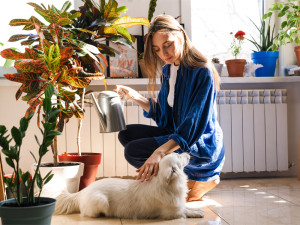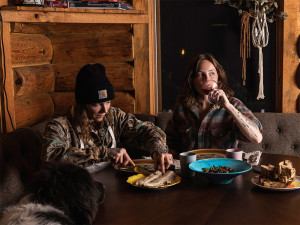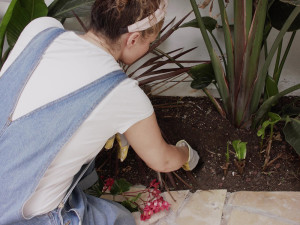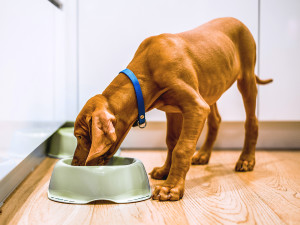Is Cultured Meat the Future of Sustainable Pet Food?
The Because, Animals co-founder on the eco-friendly way we could feed our pets.

share article

Your pet wants you to read our newsletter. (Then give them a treat.)
Kelp jerky, mushroom bacon, tapioca fish…These days, plant-based alternatives to animal products are right at our fingertips. They just haven’t quite reached our pet’s paws. Although some meatless alternative pet foods exist, they have yet to make a meaningful dent in the 1.83 million tons of animal productsopens in a new tab used to feed pets in the U.S. each year.
“People believe that their dogs and cats need meat,” Shannon Falconer, the CEO and co-founder of Because, Animalsopens in a new tab, tells The Wildest. And for good reason: Cats and dogs are taxonomic carnivores who have lived off meat in the wild for thousands of years. Although they can technically get their essential nutrients without it, it’s difficult. That’s why when Falconer, a long-time vegan, started a company to phase animals out of pet food, she didn’t look to plants. Instead, she wanted to give people exactly what they were asking for: meat — just not the type that comes from an animal.
The Appeal of Cultured Meat
Cultured meat could serve as a windfall for the sustainable pet care movementopens in a new tab and a solid option for dog and cat parents who want to reduce their pet’s environmental impact without sacrificing their nutrition. If pet food were a country, it would be the 60th highest greenhouse gas emitter, on par with Mozambique or the Philippines, according to a 2020 study. And although a lot of meat fed to pets is actually byproducts and unwanted cuts from the human meat industry, a growing demand for pet-food meat — especially specialty, “human-grade” cuts — is surpassingopens in a new tab the industry’s ability to keep up.
“The pet-food industry is very much a crux that keeps the animal agriculture industry as a whole going,” Falconer says. “If you were to pull that plug, there would be massive disruption.”
Enter: Cultured meat. Before your mind goes full-blown sci-fi, the process of making cultured meat is relatively simple. First, you extract a group of cells from an animal (which can be done without harming said animal). Then, place the cells in a medium that will allow them to duplicate quickly. Give the cells room to grow in a bioreactor, add essential nutrients, and before you know it, you have animal tissue that grew outside of an animal. Falconer says that Because, Animals (which does not use fetal bovine serum opens in a new tabor immortalized cell linesopens in a new tab to make their products) can produce as much meat in a three-week period as a cow would in two and a half years.
Who will eat first: you or your pet?
Eventually, Falconer hopes to sell her cultured meat as a branded ingredient to pet-food manufacturers and get it into dog and cat bowls nationwide. But there are a few hurdles to overcome first: One, the Center for Veterinary Medicineopens in a new tab (CVM), which operates under the Federal Drug Administration (FDA) umbrella, will need to clear the product for sale.
Because, Animals is one of the few players focused on pet food, but dozens of other companies are racing to get their cultured meat products to market. And so far, only one of them has secured FDA clearance. Late last year, the FDA deemed cultured chicken from Upside Foodsopens in a new tab, a California company that had been in business for seven years at the time, safe for human consumption. The United States Department of Agriculture (USDA) still needs toopens in a new tab inspect the company’s production plants and approve its product labeling before the “slaughter-free” chicken can be sold.
How Soon Can This Be a Reality?
The regulatory process for Because, Animals, and the other player in the cultured pet food space, Bond Pet Foodsopens in a new tab, will likely be similarly lengthy. However, Falconer is still hopeful that a 2025 release is possible.
“A significant hurdle that we don’t have, which the human food industry does have, is creating that three-dimensionality and structure quality of meat,” she says. While diners want their cultured chicken breast to actually look like a chicken and sizzle like a steak, pets are far less discerning. “Pet food already looks disgusting,” Falconer jokes, so her team doesn’t have to put in the work of embellishing their cultured meat after it’s grown.
While the finished product will look and taste a lot like your typical chow, don’t expect it to cost the same. The infrastructure for creating cultured meat is expensive, so it will need to roll out at a high price point initially. The first restaurant to serve cultured meat to humans — a high-end members club in Singaporeopens in a new tab — sells a trio of chicken nugget preparations for $23 a popopens in a new tab and still loses money on themopens in a new tab.
“We don’t necessarily have the same thing as a Michelin-star restaurant that we can sell to for pets,” Falconer notes. This means she’ll need to rely on consumers who are willing to pay a premium for their pet’s nutrition (and can get over the initial shock factor of serving meat that grew outside an animal).
So, will it be you or your pet who takes the first bite out of cultured meat? At this point, it’s anyone’s guess. If you’re hungry to move your household off of conventional animal agriculture in the meantime, use this primeropens in a new tab on the sustainable food movement.
Disclaimer alert: This article is here to share information. But, much like pineapple on pizza, the topic may be controversial. Meaning, not all vets or pet professionals agree. Because every pet is a unique weirdo with specific needs. So, don’t take this as fact or medical advice. Talk things over with your vet when making decisions, and use your best judgment (about both your pet’s health and pizza toppings).

Emma Loewe
Emma is a writer, editor, and environmentalist based in New York City. She is the senior sustainability editor at mindbodygreen, the author of Return To Nature: The New Science of How Natural Landscapes Restore Us (April 2022), and the co-author of The Spirit Almanac: A Modern Guide To Ancient Self-Care. While she doesn’t have any pets of her own, she is a loving dog aunt to Pip the pup.
Related articles
![two people preparing food for their dogs]() opens in a new tab
opens in a new tabAre Celebrity Chefs Feeding Their Pets Five-Star Meals?
These expert-approved recipes will help you use all the food in your kitchen.
![A women disposing a doggy bag in a trashcan in the park]() opens in a new tab
opens in a new tabHeads Up: Compostable Poop Bags Aren’t So Eco-Friendly After All
Gasp! “Compostable” poops bags are bad for the environment? Sustainability expert Dave Coast gets the scoop from CompostableLA founder Monique Figueiredo.
![Lauren Singer sitting on street step hugging her tan dog named Rose]() opens in a new tab
opens in a new tabDon’t Be Trashy: Follow Lauren Singer’s Low-Waste Pet Care Tips
The founder of Package Free says there’s a low-waste alternative to every pet product sitting in your trash right now.
![A woman digging a big hole in her flower bed]() opens in a new tab
opens in a new tabHow to Compost Your Pet’s Poop
Without getting totally grossed out.
![brown puppy eating food out of green bowl]() opens in a new tab
opens in a new tabA Digestible Guide to Healthy Dog Food
How to pick the right grub for your pup when there are So. Many. Choices.
![Portrait of Belgian Malinois dog sitting in the grass]() opens in a new tab
opens in a new tabSuper Snouts’ Supplements Are Organic, Vet-Formulated, and Wildly Effective
The founders’ own dog’s cancer diagnosis inspired their immunity-boosting, pathogen-resistant mushroom supplements.








